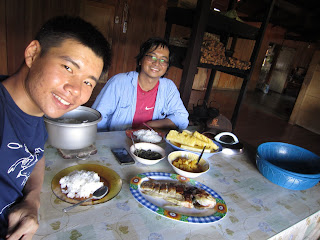I had the amazing opportunity of being partnered with
Agan Lina. He really taught me a lot of things especially about the history of
Bario Asal and the plants in Bario.
Lunch with Agan Lina
Just by going on one trail with him, I managed to learn
about more than 10 different types of plants and their uses. Here are some of
the plants you can find in Bario just by walking around:
- Daun Isip – Also known as the ‘plate of Bario’, the locals here use it to wrap their rice. In the city though, people actually just use them for aesthetics.
Nearly every family has a plantation of daun isip
Nuba layaq - Daun isip wrapped pressed rice
- Pineapples – The pineapples in Bario are so sweet and juicy, I think I will never be able to enjoy pineapples anywhere else. Besides just eating the fruit as it is, the pineapples are also made into jam. The pineapple shoots can also be harvested to be eaten as a vegetable dish.
Ripe pineapple, this is bigger than my head!
So many pineapple plants, they are usually grown on a slope
- Tapioca – People here grow/hunt nearly everything they eat, one of the most popular plants besides rice and pineapples are tapioca plants. They use the leaves as vegetables and the tubers to make snacks.
Tapioca leaves
Our strong man Jacky helping Tepuq Ribed harvest the tapioca
- Daun Keladi (Yam) – The people in Bario do not eat these yam leaves but instead feed them to the pigs. The leaves are water proof so on a rainy day, picking up a large enough leaf will keep your head dry.
It's waterproof and quite fun to play with!
They grow in wet areas and are everywhere in Bario
- Bunga Si’Ang (Rhododendron) – Grown nearly everywhere in Bario. Not only is it pretty to look at, the leaves of the plants can be crushed and mashed to treat bee stings. It is said that the flowers can be boiled to make some herbal medicine.
Pretty flower and useful too!
They grow by the road and are quite common
- Temar – The leaf of this plant is really strong. Some locals actually use the leaf to tie their bundles of daun isip, some even weave the leaves together to make straps for their basket bags. What’s more surprising is that this plant actually has fruits that are just slightly smaller than almonds but the insides are like dragon fruit flesh, white with black seeds. They were really tasty.
Daun Temar
- Wild raspberries – These raspberries just grow by the roadside and are really delicious, not too sour. It’s a pity though, these raspberries are sort of neglected and now not used as much.
I always get excited when I see ripe raspberries by the roadside in Bario
- Bario ‘asparagus’ – This plant grows in wet areas. The leaves are not edible but the stalk is. After plucking all the leaves, what remains is the stalk that looks and smells similar to asparagus.
Just randomly growing at wet areas
It really does look like an asparagus after the leaves are plucked
- Bamboo – There are three different sizes of bamboo planted in Bario. Small, medium and giant. The shoots of the small bamboos are really tender. The small and medium bamboos are used to make small bridges. The giant ones are used as building materials. You will find that bamboos are planted everywhere in Bario, this is because the bamboo actually help prevent soil erosion.
Bamboo located, but pandas not :(
- Tenem – The seeds of this plant are highly sought after by companies because they can be distilled and used as aromatics. The juice of the seeds are natural insect repellants. They mostly grow wild in Bario. The locals also use the seeds to cook fish soup.
Natural insect repellent
It's quite hard to locate unless you know that's what you are looking for
There are many more plants to be seen in Bario and it’s
really interesting to learn about them. I cannot thank Agan Lina and the other
tepuqs enough for teaching me about Bario and the plants there. I never
thought I would enjoy learning about plants this much. Just by going on one
trail, I learned so much, I wonder how much more I could have learned if I
spent more time in Bario.
Hliang (Innu)




















No comments:
Post a Comment